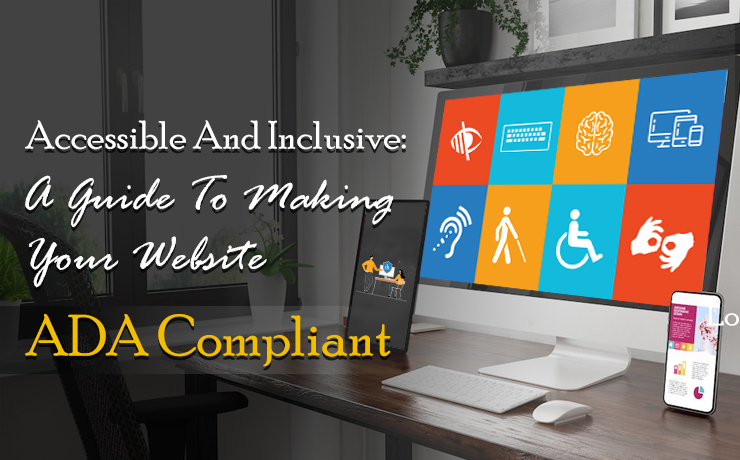Accessible And Inclusive: A Guide To Making Your Website ADA Compliant

Sam Chadson Ng
Director of Content

In a world where the internet has become a central hub for communication, commerce, and information, ensuring your website is accessible to all is not just a courtesy—it’s a necessity. Understanding how to make a website ADA compliant is crucial for creating an inclusive digital space that accommodates users with disabilities.
Understanding ADA Compliance
The Americans with Disabilities Act (ADA) sets the standard for accessible design online. An ADA compliant website ensures that people with disabilities can have full and equal enjoyment of digital resources, similar to physical public spaces.
What is ADA Compliance?
ADA compliance refers to the Website Content Accessibility Guidelines (WCAG), which provide a framework for web content that is accessible to people with a wide range of disabilities.
The Legal Imperative for Accessibility
Failing to comply with ADA standards not only excludes a significant portion of the population but also exposes businesses to legal risks. Recent lawsuits highlight the importance of compliance.
ADA Compliant Website Requirements
The ADA compliant website requirements include providing text alternatives for non-text content, creating content that can be presented in different ways, making it easier for users to see and hear content, and ensuring user navigation is accessible.
Assessing Your Website’s Accessibility
The first step in compliance is to assess your current website’s accessibility. Tools like the Web Accessibility Evaluation Tool (WAVE) can analyze your website and identify areas that need improvement.
Is My Website ADA Compliant?
To determine if your website is ADA compliant, you must ensure it adheres to the WCAG’s principles of being perceivable, operable, understandable, and robust.
Designing for All: Key Principles
Incorporating accessibility into the website design from the start is far more effective than trying to retrofit accessibility features later on.
Perceivable Information and User Interface
A perceivable UI ensures that users can identify and use your website with the senses available to them, whether that means incorporating alt text for images or providing transcripts for videos.
Implementing Technical Adjustments
Technical adjustments are often necessary to make a website ADA compliant. This might involve coding changes to ensure screen reader compatibility or designing navigation to be operable through keyboard inputs alone.
Assistive Technologies Compatibility
Your website should be compatible with various assistive technologies used by people with disabilities, such as screen readers, magnification software, and speech recognition software.
Regular Audits and Updates
An accessible website requires regular audits and updates to maintain ADA compliance as technologies and standards evolve.
Continuous Improvement
By regularly reviewing your website and implementing necessary updates, you ensure ongoing compliance and improve the user experience for all visitors.
Training and Awareness
Creating an ADA compliant website is not just a technical challenge; it involves raising awareness and training your team on the importance of accessibility.
Cultivating an Inclusive Mindset
Encouraging an inclusive mindset within your organization can lead to better decision-making around design and content creation, keeping accessibility at the forefront.
The Role of Full-Service Agencies
A full-service digital marketing agency like SmartSites can be an invaluable partner in achieving and maintaining ADA compliance for your website.
Expertise in Accessibility
SmartSites offers expertise in the latest accessibility standards, ensuring that your website not only meets legal requirements but also provides an optimal experience for users with disabilities.
Inclusive Content Strategy
An inclusive content strategy is vital to ADA compliance. This means creating content that is accessible to all users, including those with impairments.
Accessible Content Practices
Accessible content practices might include providing captions for audio and video content, using clear and simple language, and ensuring that interactive elements are designed with all users in mind.
Navigating Accessibility with User Experience in Mind
When aiming for ADA compliance, it is essential to consider the user experience (UX) for all potential visitors. A website that is accessible but difficult to navigate or understand defeats the purpose of inclusivity. Designing with UX in mind ensures that accessibility enhancements contribute positively to the overall experience of the site, rather than being seen as an afterthought or a box-checking exercise.
Balancing Aesthetics with Accessibility
Incorporating accessibility features should not come at the expense of design. Aesthetic elements and accessibility can coexist harmoniously, creating a website that is both visually appealing and functional for a diverse range of users. This balance is where the expertise of a digital agency can be particularly beneficial, as professionals can execute design decisions that cater to both form and function.
Embracing Accessibility as a Standard
Making your website ADA compliant is a commitment to inclusivity and a recognition of the diversity of your user base. It is about ensuring that everyone has access to the information and services you provide, regardless of ability. With the right approach and expertise, your website can become a model of accessibility, opening your digital doors to all users.









